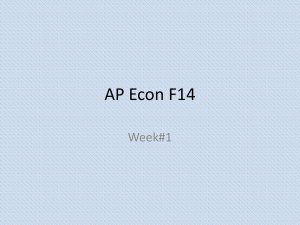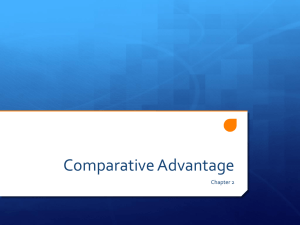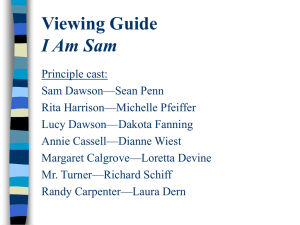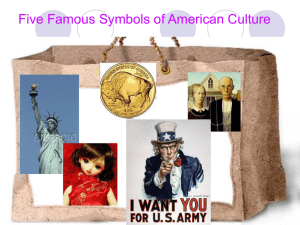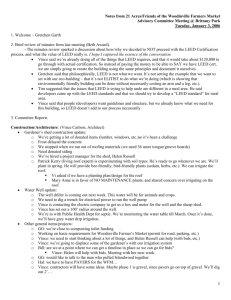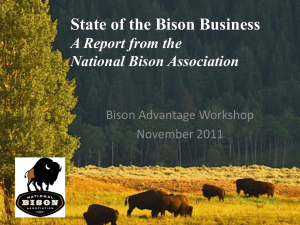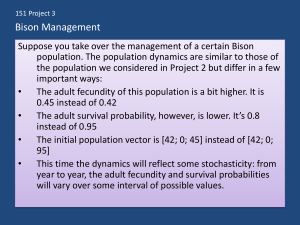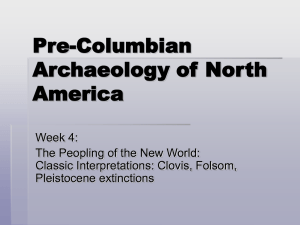Chapter_02_Micro_online_14e
advertisement
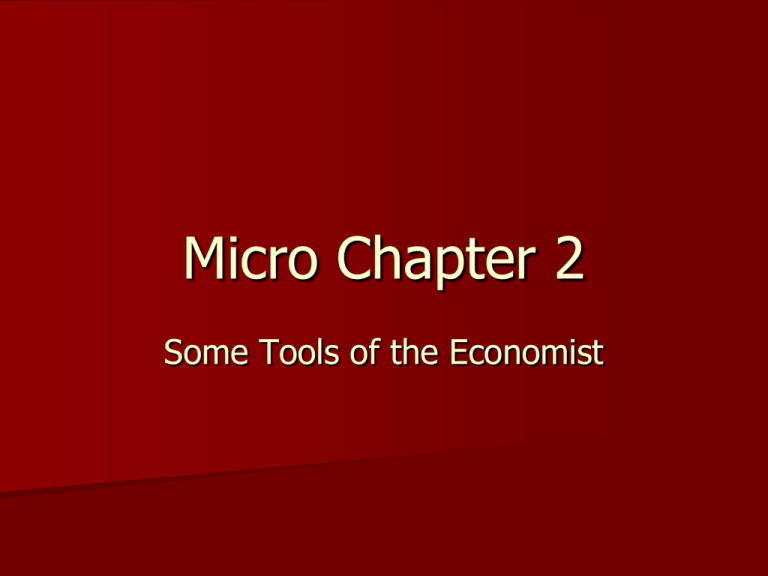
Micro Chapter 2 Some Tools of the Economist 6 Learning Goals 1) Define and recognize examples of opportunity costs (repeat of Chapter 1) 2) Discern why voluntary trade creates value 3) Realize why property rights are key to economic progress 4) Illustrate the concepts of tradeoffs, opportunity costs, and growth 5) Recognize that specialization and division of labor lead to higher output levels and living standards 6) List society’s three questions and specify the kinds of economic organizations Trade Creates Value Two opposing views of trade: 1. When people trade, one person gains and the other person loses Referred to as a zero-sum game Watch video: Wall Street- zero sum game Two opposing views of trade: 2. When people trade, both parties gain Wealth is actually created by trade Watch video: Stossel Micro 14- Is making money good or bad? Q2.1 (Multiple Answer) Sam values his boat at $4,000, and Brenda values it at $9,000. If Brenda buys it from Sam for $7,000, which of the following is true? 1) 2) 3) 4) 5) 6) 7) 8) Brenda loses $7,000 Brenda gains $2,000 Brenda gains $5,000 Brenda gains $9,000 Sam loses $4,000 Sam loses $7,000 Sam gains $3,000 Sam gains $7,000 Voluntary trade creates wealth and promotes economic progress Voluntary trade is expected to benefit both parties involved, otherwise it wouldn’t occur. Potential trades: 1) Barter- exchange without money; goods for goods 2) Money- exchange goods for money Class Activity: What could reduce the value created from a voluntary transaction? Example: surfing the web looking for airline tickets The Importance of Property Rights 2 Kinds of Property Rights: (1) Common rights – everybody owns it (2) Private rights – only one person owns it Q2.2 When property rights are clearly defined and enforced, private owners will 1) use their property for selfish ends because they have little or no incentive to consider the desires of others. 2) develop and direct their property toward uses that others value highly because the market will generally reward them for doing so. 3) have little or no incentive to take care of their property or conserve it for the future. 4) be unable to derive personal gain if they are sensitive to the desires of others when deciding how to use their property. Property rights change the incentives for individuals Watch video: Stossel Micro 02economics of private property Supplemental Video: Stossel- private property and Native Americans (optional) Q2.3 In the fictitious country of Econoland, the government allows private ownership of chickens but not of bison. If the demand for chicken and the demand for bison both permanently increased in Econoland, we would expect 1. the population of chickens to rise and the population of bison to fall. 2. the population of bison to rise and the population of chickens to fall. 3. the populations of both chickens and bison to increase. 4. both chickens and bison to become extinct in Econoland unless the government places the animals on the endangered species list. Incentives created by private property rights: Give proper care Conserve for the future Use resources in ways other people value Mitigate possible harm to others Production Possibilities Curve PPC also called PP Frontier Graph: Watch content video: Micro Chapter 2creating PPC The PPC can shift Graph: Watch content video: Micro Chapter 2- shifting PPC The PPC can shift Watch video: A Knight’s Tale- PPC shift A great example of trade-offs comes from the life of a fulltime student. Such students can be imagined as having only two uses of their time- studying and socializing- and two outputs from those uses- knowledge acquired and social satisfaction. If a student is efficient, he or she cannot increase the amount of knowledge acquired in college without giving up social satisfaction. The opportunity cost of one more unit of social satisfaction is some amount of forgone knowledge, and the opportunity cost of another unit of knowledge is forgone social satisfaction. This production possibility frontier can shift out along each axis. A speed-reading course moves the curve out along the axis for knowledge acquisition, allowing the student to obtain both more knowledge and more social satisfaction (because some time that can be saved from studying can be shifted to socializing). Q: Draw the production possibility frontier implied in this story. List one other example of a technical improvement that shifts the frontier out the learning axis, and one other that shifts it out the social satisfaction axis. Q2.4 Over time, an increase in a person's education (i.e. stock of human capital) will 1. shift that person’s production possibilities curve inward. 2. cause a person to operate inside its production possibilities curve (i.e. become unemployed). 3. shift that person’s production possibilities curve outward. 4. eliminate the basic economic problem of scarcity. Trade, Output, and Living Standards My wife and I needed to move 40 pieces of fencing, all with nails in them, from behind the house out to the street, and the nails had to be removed before the trash collectors would take the fencing. How to organize the task? There are three activities: dragging the wood, pounding the nails with a hammer so the heads stick up, and pulling the nails out with pliers. We figured that I have an absolute advantage in all three activities, but my wife probably had a comparative advantage in using the hammer. To minimize time spent on the activity, I dragged the wood, she hammered, and I plied. As the morning progressed, we each got faster at our tasks- our production possibility frontiers moved outward. By the end of the task, she may have developed an absolute advantage at hammering, so that our technological improvements increased each of our comparative advantages in the three tasks. Q: Having developed our skills in these tasks, should we now go into business offering our services in removing fencing? Why or why not? Law of Comparative Advantage Make the good for which you have a low opportunity cost and trade for the good for which you have a high opportunity cost. Translation: make something you’re good at and trade for something you’re not good at. Q2.5 According to the law of comparative advantage, both individuals and nations will be able to produce a larger joint output if each productive activity is undertaken by 1. the high opportunity cost producer. 2. the low opportunity cost producer. 3. the producer who is able to hire workers at the lowest wage. 4. the party that can complete the productive activity most rapidly. Q2.6 If Kim can either wash 10 cars or wax 2 cars during a day, and Vince can either wash 17 cars or wax 2 cars during a day, then according to the law of comparative advantage, 1. 2. 3. 4. Vince's opportunity cost of waxing a car is less than Kim's. their total output can be expanded if Kim specializes in waxing and Vince in washing. their total output can be expanded if Kim specializes in washing and Vince in waxing. it would be impossible for Vince and Kim to increase their total output through specialization and mutual exchange. Watch video: Stossel Micro 13Investment versus giving Watch video: Made in America- Welch’s juice Importance of Comparative Advantage Low opportunity cost Comparative advantage Specialization Division of labor Voluntary trade Increased wealth Watch video: Pawn Stars- Haggling 101 Adam Smith, Wealth of Nations “I have seen a small manufactory of this kind where ten men only were employed, and where some of them consequently performed two or three distinct operations. But though they were very poor, and therefore but indifferently accommodated with the necessary machinery, they could, when they exerted themselves, make among them about twelve pounds of pins in a day. There are in a pound upwards of four thousand pins of a middling size. Those ten persons, therefore, could make among them upwards of forty-eight thousand pins in a day. But if they had all wrought separately and independently, and without any of them having been education to this peculiar business, they certainly could not each of them have made twenty, perhaps not one pin in a day.” Self-sufficiency is the quickest and most absolute path to poverty Economic Organization Society’s three questions: 1) What to produce? 2) How to produce? 3) For whom to produce? Watch content video: Micro Chapter 2economic organization Question Answers Q2.1 = 2 & 7 Q2.2 = 2 Q2.3 = 1 Q2.4 = 3 Q2.5 = 2 Q2.6 = 2


